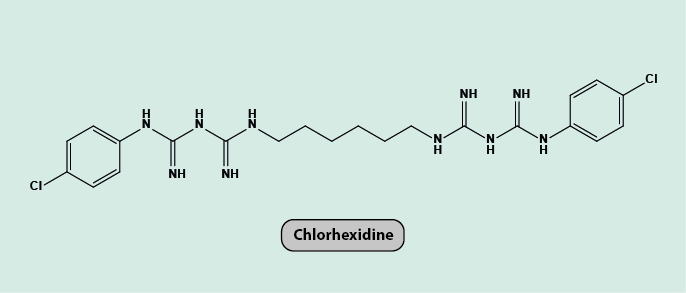Chlorhexidine
Chlorhexidine is an effective and widely used skin and mucosa (lining of the mouth) antiseptic, with antibacterial and antifungal properties. It is included on the World Health Organisation list of the safest and most effective medicines. It is less of an irritant to the tissue than iodine and is an alternative for skin disinfection when allergy to iodine is a problem.
Chlorhexidine is widely used for skin disinfection before surgery (including ‘scrubbing up’ of the surgeon) and for the cleaning of wounds . There is some evidence suggesting that chlorhexidine is a slightly more effective skin disinfectant than various iodine preparations used for the same purpose.
Chlorhexidine is otherwise probably best known in its role as a mouthwash component (as the active component in several well-known, over the counter, branded products). As ingredient in a mouthwash it is used to prevent or treat fungal and bacterial infections after oral surgery, as well as in everyday oral hygiene routines. Its antiseptic properties are particularly useful when regular oral hygiene routines, using a toothbrush or other mechanical tools, are difficult or impossible. Owing to its particular chemical properties (Figure 1), chlorhexidine is thought to be slightly more effective than other mouthwashes in preventing and treating oral infections.

Chlorhexidine belongs to a class of chemicals (bisbiguanides) with antibacterial properties. It is mostly used in the form of a solution of one of its salts, and in this cationic (positively charged) form sticks to skin, mucosa and the enamel of teeth for extended periods of time (assumed to be the reason for its enhanced effectiveness). The same trait of chemical properties also explains why chlorhexidine mouthwashes should not be used immediately after brushing teeth: chlorhexidine reacts with the anionic (negatively charged) components and detergents in toothpastes, forming an insoluble material that has little protective effects. Optimal use of chlorhexidine mouthwash should include a delay of at least 30 minutes between the use of toothpaste and the chlorhexidine mouthwash.
The antibacterial and antifungal properties of chlorhexidine originate from exactly this ability of adhesion to surfaces: chlorhexidine interferes with the cell wall surfaces of bacteria and fungi (as many antibacterial and antifungal agents do). This interference stops the growth (bacteriostatic) of infectious microorganisms at relatively low dosage, chlorhexidine at higher dosage acts as a bactericidal agent and kills bacteria (and fungi) by complete disruption of their cell walls.
Chlorhexidine is active against a range of Gram-positive and Gram-negative bacteria (facultative anaerobes as well as aerobes) and a range of fungi, with a range of antimicrobial activity depending on the species.
Unwanted effects of the extended use of chlorhexidine in its use as a mouthwash ingredient include damage to the mucosa, staining of teeth and soft tissues, and occasionally a distorted sense of taste. A range of different preparations of chlorhexidine mouthwashes is available, with a view to reducing adverse effects of, and improving compliance with, its use. Many chlorhexidine mouthwash preparations include alcohol (ethanol or isopropanol) which may exacerbate dry mouth problems (xerostomia) – alcohol-free preparations are preferable in such circumstances.
Staining of teeth and soft tissues can be a disincentive to use chlorhexidine mouthwashes (although it is a reversible effect that is easily dealt with by a professional dental hygienist). The degree of staining depends on duration of use, overall dosage and diet. Just as chlorhexidine interacts with some ingredients in toothpaste, or with the cell walls of bacteria, it also interacts with proteins in food, especially tannins (prominently present in tea, coffee and red wine). Alternative non-staining (or: less-staining) formulations are available. Studies suggest that non-staining chlorhexidine mouthwash preparations are equally effective as antiseptics and in preventing the build-up of bacterial plaque as the original formulations.
There have been case reports of allergic reactions to chlorhexidine, although these have mostly been in relation to indwelling catheters coated with the antiseptic.